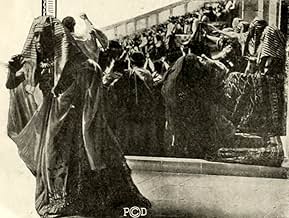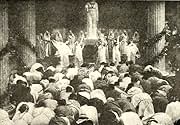AVALIAÇÃO DA IMDb
6,1/10
648
SUA AVALIAÇÃO
Adicionar um enredo no seu idiomaTwo love triangles intersect in ancient Pompei.Two love triangles intersect in ancient Pompei.Two love triangles intersect in ancient Pompei.
- Direção
- Roteiristas
- Elenco e equipe completos
- Produção, bilheteria e muito mais no IMDbPro
Avaliação em destaque
Despite its old-fashioned format and performances, this early full-length feature is still of some interest, at least historically, and it is probably a little better as a movie than many give it credit for. It was quite an ambitious attempt to tell a relatively involved story with some large-scale settings and a few special visual effects.
It follows a formula that may be even more popular now than it was in the 1910's: take a tumultuous historical event, introduce a set of fictional characters, and show what was going on in their lives when the event took place. In this respect, "The Last Days of Pompeii" may to some degree have established the formula that is still being used for films such as "Titanic", "Pearl Harbor" and many others. If you adjust for the limitations of its era, "The Last Days of Pompeii" is at least as good as those films, as well as many others of the genre.
The story, though sometimes too melodramatic and implausible, is interesting enough most of the time, and while the settings aren't going to impress anyone now, they do display a fair amount of creative effort. None of the cast give particularly strong performances, but their acting styles are not inherently any worse than the acting styles of the present. Some of the present day's most popular performers use affected, artificial styles that are trendy now, but that won't look any better in 90 years than the histrionics of this Italian cast look today.
There's no denying the weaknesses, many of which come from the tableau format and/or from inexperience with telling a full-length story on the silent screen. There are some stretches, especially in the first half, which move very slowly. Some of the characters, especially Nidia, could have been much more compelling with more creative filming and acting.
Within just a few years, the stereotyped tableau format would be largely abandoned, better ways of telling a story would be developed, and better ways of integrating the camera and the performers would be devised. While that might not make this film any better in itself, it was the first few ambitious attempts like "The Last Days of Pompeii" that helped lead to such improvements. While it's only an average film in itself, it deserves also to be remembered as a pioneering effort.
It follows a formula that may be even more popular now than it was in the 1910's: take a tumultuous historical event, introduce a set of fictional characters, and show what was going on in their lives when the event took place. In this respect, "The Last Days of Pompeii" may to some degree have established the formula that is still being used for films such as "Titanic", "Pearl Harbor" and many others. If you adjust for the limitations of its era, "The Last Days of Pompeii" is at least as good as those films, as well as many others of the genre.
The story, though sometimes too melodramatic and implausible, is interesting enough most of the time, and while the settings aren't going to impress anyone now, they do display a fair amount of creative effort. None of the cast give particularly strong performances, but their acting styles are not inherently any worse than the acting styles of the present. Some of the present day's most popular performers use affected, artificial styles that are trendy now, but that won't look any better in 90 years than the histrionics of this Italian cast look today.
There's no denying the weaknesses, many of which come from the tableau format and/or from inexperience with telling a full-length story on the silent screen. There are some stretches, especially in the first half, which move very slowly. Some of the characters, especially Nidia, could have been much more compelling with more creative filming and acting.
Within just a few years, the stereotyped tableau format would be largely abandoned, better ways of telling a story would be developed, and better ways of integrating the camera and the performers would be devised. While that might not make this film any better in itself, it was the first few ambitious attempts like "The Last Days of Pompeii" that helped lead to such improvements. While it's only an average film in itself, it deserves also to be remembered as a pioneering effort.
- Snow Leopard
- 11 de out. de 2004
- Link permanente
Enredo
Você sabia?
- CuriosidadesFor a while in the late summer and fall of 1913 there were two major Italian productions on this subject playing simultaneously in the US, this one produced by Ambrosio, and Jone ovvero gli ultimi giorni di Pompei (1913), produced by Pasquali.
- Erros de gravaçãoExtras are "killed" by falling pieces of a set during the explosion scene, then appear to either get back up or adjust themselves so that they won't be trampled by other extras.
- Versões alternativasKino International Corp. copyrighted a version in 2000 with a piano music score compiled and arranged by Beatrice Jona Affron and performed by Martha Koeneman. It was produced for video by Bret Wood and runs 88 minutes.
- ConexõesFeatured in Cinema Europe: The Other Hollywood: Where It All Began (1995)
- Trilhas sonorasGiselle
Written by Adolphe Adam (as Adam)
Arranged by Beatrice Jona Affron
Performed by Martha Koeneman
Excerpts in the 2000 alternate version score
Principais escolhas
Faça login para avaliar e ver a lista de recomendações personalizadas
Detalhes
- Data de lançamento
- País de origem
- Idiomas
- Também conhecido como
- The Last Days of Pompeii
- Empresa de produção
- Consulte mais créditos da empresa na IMDbPro
- Tempo de duração1 hora 28 minutos
- Cor
- Mixagem de som
- Proporção
- 1.33 : 1
Contribua para esta página
Sugerir uma alteração ou adicionar conteúdo ausente

Principal brecha
By what name was Os Últimos Dias de Pompeia (1913) officially released in Canada in English?
Responda





















